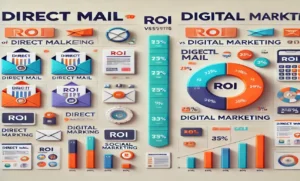Challenges and Opportunities in InsurTech Marketing

The world of insurance is changing fast. With the rise of Technology, we have a new term: InsurTech. InsurTech combines “insurance” and “technology” to create better insurance services. Marketing InsurTech can be tricky, but it also brings many new chances. Let’s explore both the challenges and opportunities in InsurTech marketing.
Understanding InsurTech
InsurTech stands for insurance technology, a term that encompasses the innovative use of Technology to enhance and streamline the insurance industry. At its core, InsurTech leverages advancements like big data, artificial intelligence (AI), and blockchain to revolutionize traditional insurance practices.
Big Data: InsurTech companies utilize big data to collect and analyze vast amounts of information. By embracing a data-driven approach, insurers gain valuable insights into customer needs, allowing them to offer more personalized products, improve risk assessment accuracy, and deliver tailored coverage. For example, insurers can create customized auto insurance policies based on individual driving behavior by analyzing driving habits through telematics data.
Artificial Intelligence: AI plays a crucial role in automating processes and improving decision-making in InsurTech. AI-powered chatbots provide 24/7 customer service, handling claims, answering queries, and offering policy advice. Where human eyes struggle, machine learning excels. By analyzing data for subtle anomalies and patterns, these algorithms become powerful allies in fraud detection.
Blockchain: Blockchain technology ensures secure and transparent transactions. In InsurTech, blockchain can be used for smart contracts, which automatically execute and verify insurance agreements when certain conditions are met. This reduces administrative costs and the potential for disputes, making the claims process faster and more efficient.
InsurTech companies aim to make insurance faster, cheaper, and more user-friendly. By integrating these advanced technologies, they enhance customer experiences, reduce operational costs, and introduce innovative insurance products catering to modern consumers’ needs. InsurTech continues to push the boundaries as the industry evolves, driving significant improvements in how insurance services are delivered and consumed.
Challenges in InsurTech Marketing
Marketing InsurTech products takes work. Here are some major challenges:
Regulatory Compliance
Insurance is a highly regulated industry, and this complexity extends to InsurTech. Every country has its own set of rules and regulations governing the insurance sector. These laws cover various issues, from how insurance products are marketed to how customer data is handled. InsurTech companies must navigate these regulations carefully to avoid legal repercussions.
Ensuring marketing materials comply with local laws is crucial, as regulations around advertising and consumer protection can vary dramatically from country to country. Ensuring compliance with local laws, which can vary significantly, can slow down marketing campaigns. Companies need a comprehensive understanding of the regulatory environment in each market they operate in.
Data Privacy Concerns
InsurTech companies depend extensively on data to deliver tailored insurance services. They collect data from various sources, including customer interactions, social media, and wearable devices. While this data-driven approach allows for more tailored insurance products, it raises significant data privacy concerns.
Data privacy is a top priority for customers, who are increasingly wary of how businesses handle their information. InsurTech companies must prioritize data security and privacy, implementing robust measures to protect customer information. Demonstrating a commitment to data security is essential for any InsurTech marketing strategy, as it builds trust with customers who are increasingly privacy-conscious.
Building Trust with Customers
Trust is a cornerstone of the insurance industry. Customers need to feel confident that their insurer will support them in need. This is particularly challenging for new InsurTech companies, which may need to have the established reputation of traditional insurers. Building this Trust requires consistent, transparent communication and excellent customer service.
InsurTech companies must demonstrate reliability and empathy, showing customers they are committed to their well-being. This can be achieved through customer testimonials, transparent business practices, and clear, straightforward information about insurance products.
High Competition
The InsurTech market is expanding rapidly, attracting numerous startups and established tech companies looking to capitalize on the potential of Technology in insurance. This influx of competitors makes it challenging for companies to stand out. Effective differentiation requires innovative marketing strategies that highlight unique value propositions.
InsurTech companies must constantly innovate and find creative ways to communicate their advantages over competitors. This can involve leveraging cutting-edge Technology, offering superior customer experiences, or providing unique insurance products that address unmet needs in the market.
Technological Integration
Incorporating new technologies into legacy insurance systems can present significant challenges. Many traditional insurance companies still need to operate on updated infrastructure, making it difficult to implement new technologies seamlessly. InsurTech companies must invest considerable time and resources to ensure their technological solutions are compatible with existing systems. Integration can be both costly and complex. Still, delivering the enhanced services that modern customers expect is essential.
A smooth technological integration ensures that InsurTech companies can provide efficient, reliable services without disruptions, which is crucial for maintaining customer satisfaction and Trust.
While InsurTech offers exciting opportunities to revolutionize the insurance industry, marketing these products comes with significant challenges. Companies must navigate regulatory complexities, address data privacy concerns, build customer trust, stand out in a crowded market, and ensure seamless technological integration. Addressing these challenges empowers InsurTech companies to develop effective marketing strategies. By resonating with their target audience, these strategies will propel growth within the ever-evolving InsurTech sector.
Opportunities in InsurTech Marketing
Despite the challenges, there are many opportunities in InsurTech marketing:
Personalized Customer Experiences
The ability to personalize customer experiences is where InsurTech marketing truly shines. InsurTech companies can collect and analyze vast amounts of customer information by leveraging big data. This data can include everything from a customer’s purchasing history to their behavior on digital platforms. By leveraging these insights, companies can customize insurance plans to address the unique needs of each customer.
Personalized insurance plans lead to higher customer satisfaction because they address the unique requirements of each policyholder. Moreover, when customers feel that an insurance product is designed just for them, their loyalty to the brand increases, enhancing long-term retention rates.
Data-Driven Insights
Data analytics is a powerful tool for InsurTech companies. Companies can better understand customer behaviors, preferences, and needs through data-driven insights. Leveraging this data and armed with this knowledge, InsurTech firms can craft laser-focused marketing campaigns that connect deeply with specific customer groups.
For example, data analytics can reveal which types of insurance products are most popular among different age groups or geographic locations. By using this information, companies can craft messages that appeal directly to these groups, improving the effectiveness of their marketing efforts. Additionally, data-driven insights can help optimize pricing strategies, predict market trends, and identify new business opportunities.
Innovative Product Offerings
Technology allows InsurTech companies to develop innovative and unique insurance products that traditional insurers might not offer. These products can cater to niche markets or provide solutions for emerging risks. For instance, some InsurTech firms offer microinsurance policies that cover specific events, such as travel delays or smartphone damage. Others may provide usage-based insurance, where premiums are calculated based on real-time data, such as driving habits. These innovative offerings can attract a broader audience, including tech-savvy consumers and younger generations who might not be interested in traditional insurance products.
Strategic Partnerships
Forming strategic partnerships with traditional insurance companies or technology firms presents significant opportunities for InsurTech companies. These partnerships can provide access to new markets, customer bases, and advanced technologies. For example, collaborating with a well-established insurance company can help an InsurTech startup gain customer credibility and Trust. On the other hand, partnering with tech firms can provide access to cutting-edge technologies like artificial intelligence, machine learning, and blockchain, enabling InsurTech companies to enhance their offerings and stay competitive.
Digital Marketing Channels
Digital marketing channels offer cost-effective ways to reach and engage potential customers. Social media platforms, email marketing, and search engine optimization (SEO) are powerful tools for increasing visibility and attracting new clients. Social media bridges the gap between InsurTech companies and their customers, fostering direct interaction and building a loyal following. Email marketing can nurture leads and inform existing customers about new products and updates.
By optimizing for SEO, the company’s website becomes more visible to online users seeking insurance solutions. InsurTech companies can expand their reach, generate leads, and boost conversions by leveraging these digital marketing channels.
While InsurTech marketing faces its fair share of challenges, the opportunities are equally compelling. Personalized customer experiences, data-driven insights, innovative product offerings, strategic partnerships, and digital marketing channels all provide avenues for growth and success. By capitalizing on these opportunities, InsurTech companies can effectively navigate the competitive landscape and build strong, lasting customer relationships.
Best Practices for InsurTech Marketing
To succeed in InsurTech marketing, follow these best practices:
1. Understand Your Audience
A solid understanding of your audience is the cornerstone of successful marketing. It’s essential to know who your customers are and what their needs entail. Use data analytics to collect information about your customers’ demographics, behaviors, and preferences. This information unlocks a deeper understanding of your target audience, allowing you to develop realistic customer personas. Details like age, gender, occupation, interests, and pain points should be included in these personas. Understanding your audience unlocks the power to personalize your marketing, ensuring messages are relevant and impactful.
2. Build Trust
Trust is paramount in the insurance industry. Customers need to feel confident that their personal information is safe and that their insurer will support them in times of need. To build trust, be transparent about how you use customer data. Clearly explain your data privacy policies and how you protect customer information.
Demonstrating a commitment to privacy and security can reassure customers and foster loyalty. Additionally, provide excellent customer service and be responsive to customer inquiries and concerns. Trust can also be built through customer testimonials and reviews, highlighting positive experiences with your company.
3. Leverage Technology
Leveraging the latest Technology can enhance your services and marketing strategies. Use big data and artificial intelligence to analyze customer data and gain insights into their needs and behaviors. Implement chatbots and automated systems to improve customer service and provide quick responses to inquiries. Blockchain technology can be used to ensure secure and transparent transactions. Embracing these technologies improves efficiency and enhances the customer experience, making your company more competitive in the market.
4. Create Quality Content
Elevate your brand as an InsurTech authority through content marketing. Provide insightful content that establishes you as a thought leader, such as blog articles, videos, infographics, and social media posts. Address common customer questions, industry trends, and demonstrate the unique value your products offer in solving their problems. Earn the trust of your audience. By consistently providing valuable content, you build lasting relationships and solidify your brand as an authority.
5. Engage on Social Media
Social media platforms can be used to share updates, promote content, and interact with customers. Turn followers into fans. Creating a loyal brand community hinges on effective social media engagement. Promptly responding to comments and messages is crucial, as it demonstrates attentiveness and care towards your audience.
Additionally, encouraging user-generated content by inviting customers to share their experiences with your products can further strengthen the bond between your brand and its community. Social media can also be valuable for gathering feedback and understanding customer sentiment.
6. Optimize for SEO
Search engine optimization (SEO) is essential for improving your online visibility. Ensure your website is SEO-friendly by using relevant keywords, creating high-quality content, and optimizing your site’s structure and speed. Engaging in thorough keyword research is essential in order to identify the terms that potential customers are actively searching for. Integrating these keywords seamlessly into your content will not only attract organic traffic but also enhance your website’s search engine optimization (SEO).
To further optimize your site, make sure to use appropriate meta tags, incorporate alt text for images, and utilize internal linking. These strategies will bolster your site’s visibility and improve its ranking on search engine results pages. Lastly, it is vital to regularly update your website with fresh and relevant content. This practice ensures that your site remains current, appealing to both visitors and search engines, thus maintaining its ranking and attracting continued traffic.
7. Measure and Adapt
Marketing is a journey, not a destination. With analytics tools like Google Analytics, you can track website traffic, bounce rates, and conversions. Analyze this data to identify areas for improvement and continuously refine your marketing strategies for long-term success. For example, if a particular type of content drives more traffic, consider creating more of that content. Regularly reviewing and adjusting your marketing strategies ensures you stay responsive to changing customer needs and market conditions.
Implementing these best practices can significantly enhance your InsurTech marketing efforts. By understanding your audience, building Trust, leveraging Technology, creating quality content, engaging on social media, optimizing for SEO, and continuously measuring and adapting your strategies, you can effectively reach and engage your target audience. These practices help attract new customers and retain existing ones, fostering long-term growth and success in the competitive InsurTech market.
Conclusion
Marketing in the Insurance Technology industry comes with its own set of challenges and opportunities. By understanding and addressing these, Insurance companies can effectively reach their target audience. Leveraging Technology, Building Trust, and creating personalized experiences is key to success. With the right strategies, the future of Insurance Technology marketing looks promising.
FAQs – Challenges and Opportunities in InsurTech Marketing
What is InsurTech?
InsurTech involves utilizing technology to improve and simplify processes within the insurance industry.
Why is regulatory compliance a challenge in InsurTech marketing?
Insurance is a highly regulated industry with different rules in each country, making compliance complex.
How can InsurTech companies build Trust with customers?
By being transparent, ensuring data privacy, and providing excellent customer service.
What are the opportunities in InsurTech marketing?
Opportunities include personalized customer experiences, data-driven insights, innovative products, strategic partnerships, and digital marketing.
Why is data privacy important in InsurTech?
Customers need to feel that their personal information is safe and secure.






